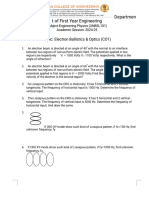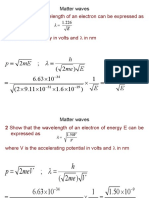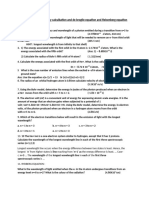0 ratings0% found this document useful (0 votes)
15 viewsTutorial 1 Solution
The document contains numerical problems involving De Broglie's equation and Heisenberg's uncertainty principle. It provides the calculations to find momentum, wavelength, velocity, position and other uncertainties given various particle properties like mass and wavelength. All the calculations are shown with the relevant formulas and steps.
Uploaded by
TENZIN WANGCHUKCopyright
© © All Rights Reserved
Available Formats
Download as PDF, TXT or read online on Scribd
0 ratings0% found this document useful (0 votes)
15 viewsTutorial 1 Solution
The document contains numerical problems involving De Broglie's equation and Heisenberg's uncertainty principle. It provides the calculations to find momentum, wavelength, velocity, position and other uncertainties given various particle properties like mass and wavelength. All the calculations are shown with the relevant formulas and steps.
Uploaded by
TENZIN WANGCHUKCopyright
© © All Rights Reserved
Available Formats
Download as PDF, TXT or read online on Scribd
You are on page 1/ 4
Numericals on De Broglie’s Equation
1. Calculate the momentum of a particle which has a wave length of 2Å (h
= 6.6 x 10-34kgm2sec-1) (ans = 3.3 x 10-24kgms-1)
Given:
Wave length of 2Å = 2 x 10-10m, h=6.6 x 10-34kgm2sec-1
The De-Broglie Wavelength of a particle is given as:
λ= h/p
p=h/λ
p = 6.6 x 10-34kgm2sec-1 / 2x 10-10m
p = 3.3 x 10-24kgms-1
2. Calculate the wavelength associated with a body of mass 1mg moving
with a velocity of 10ms-1. (h = 6.6 x 10-34kgm2sec-1)(ans = 6.6 x 10-29m)
Mass = 1 mg = 1 x 10-6 kg
We know from de Broglie relation;
λ = h/mv
λ = 6.6x10-34 kgm2sec-1 /10-6 kg x10 ms-1
λ = 6.63 x 10-29 m
3. A beam of electrons has a wavelength of 100Å. Find out the velocity of
this beam. (h = 6.6 x 10-34kgm2sec-1) (ans = 7.235 x 104ms-1)
Given:
Wave length of 100 Å = 100 x 10-10 m, h=6.6 x 10-34kgm2sec-1
m = 9.1 x 10-31 kg
We know from de Broglie relation;
λ = h/mv
v = h / λm
v = 6.6x10-34 kgm2sec-1 /100 x 10-10 m x 9.1 x 10-31 kg
v = 7.25 x 104 ms-1
4. An electron is moving with a kinetic energy of 4.55 x 10-25J. Calculate
wavelength and frequency of the particle wave (h = 6.6 x 10-34kgm2sec-
1 and m = 9.1 x 10-31kg) (ans λ= 7.318 x 10-7m, v = 1.366 x 109
s-1)
We know that K.E=1/2 mv2
v2 = 2 K.E / m
v2 = 2 x 4.55 x 10-25 J / 9.1 x 10-31 kg
v2 = 10 6
v = 10 3 ms-1
λ = h/mv
λ = 6.6x10-34 kgm2sec-1 / 9.1 x 10-31 kg x 10 3 ms-1
λ = 7.25 x 10-7 m
ν = c/ λ
ν = 103 ms-1 / 7.25 x 10-7 m
ν = 1.37 x 109 s-1
Numericals on Heisenberg’s Uncertiainty Principle
1. Calculate the uncertainty in position of an electron if uncertainty in
velocity is 5.7 x 10-5 ms-1 (h = 6.6 x 10-34kgm2sec-1 and m = 9.1 x 10-31kg)
(ans = 1.012m)
Δv . Δx =h/4π m
Δx = h/ 4πm x Δv
Δx = 6.6 x 10-34kgm2sec-1 / 4π x 9.1 x 10-31 kg x 5.7 x 10-5 ms-1
Δx = 1.012 m
2. Calculate the uncertainty in the velocity of a wagon of mass 1000kg,
whose position while in motion, is known to an accuracy of ±10m. (h =
6.6 x 10-34kgm2sec-1)(ans = 0.5249 x 10-38ms-1)
Δv . Δx =h/4π m
Δv = h/4π m x Δx
Δv = 6.6 x 10-34kgm2sec-1 / 4π x 1000 kg x 10 m
Δv = 0.525 x 10-38 ms-1
3. Calculate the product of uncertainties of displacement and velocity of a
moving electron having a mass of 9.1 x 10-28g. (h = 6.6 x 10-34kgm2sec-1)
(ans = 5.768 x 10-5m2s-1)
Δv . Δx = h/4π m
Δv. Δx = h/4π m
Δv. Δx = 6.6 x 10-34 kgm2sec-1 / 4π x 9.1 x 10-31 kg.
Δv. Δx = 5.768 x 10-5m2s-1
4. Calculate the uncertainty in the velocity of an electron, if the
uncertainty in its position is 1.0 x 10-10 m. (h = 6.6 x 10-34kgm2sec-1, m =
9.1 x 10-31kg)(ans = 5.768 x 105ms-1)
Δv . Δx =h/4π m
Δv = h/4π m x Δx
Δv = 6.6 x 10-34kgm2sec-1 / 4π x 9.1 x 10-31kg x 1.0 x 10-10 m
Δv = 5.77 x 105 ms-1
You might also like
- 66e9414e7c9fb482174f7e7f - ## - Structure of Atom - Solution Notes To DPP 06 - Yakeen NEET 2.0 2025 (Alpha)No ratings yet66e9414e7c9fb482174f7e7f - ## - Structure of Atom - Solution Notes To DPP 06 - Yakeen NEET 2.0 2025 (Alpha)30 pages
- Practice Problem - Atomic Structure - ETC EnggNo ratings yetPractice Problem - Atomic Structure - ETC Engg1 page
- Dual Nature of Matter & Uncertainity PrincipleNo ratings yetDual Nature of Matter & Uncertainity Principle2 pages
- Unit I Wave Mechanics & X-Ray Diffraction Tutorial100% (1)Unit I Wave Mechanics & X-Ray Diffraction Tutorial2 pages
- 'DPP-7 de Broglie and Heisenberg Uncertainty Principle' With YouNo ratings yet'DPP-7 de Broglie and Heisenberg Uncertainty Principle' With You3 pages
- Class 8 - Module 1 - Problems - DR - Ajitha - PHY1701No ratings yetClass 8 - Module 1 - Problems - DR - Ajitha - PHY170115 pages
- De-Broglie Wave Theory, Heisenberg Uncertainity PrincipleNo ratings yetDe-Broglie Wave Theory, Heisenberg Uncertainity Principle5 pages
- Physics - Numericals - APPLIED PHYSICS - ENGINEERING 1st Year100% (1)Physics - Numericals - APPLIED PHYSICS - ENGINEERING 1st Year16 pages
- Solution Numerical Problem Module1 BSCM101No ratings yetSolution Numerical Problem Module1 BSCM1014 pages
- MODULE - 4 Quantum Mechanics and LasersNo ratings yetMODULE - 4 Quantum Mechanics and Lasers30 pages
- Unit-4 Quantum Mechanics and Qauntum ComputingNo ratings yetUnit-4 Quantum Mechanics and Qauntum Computing19 pages
- PDF_GO_EXTRA CLASS NOTE PHYSICS 2ND 2025No ratings yetPDF_GO_EXTRA CLASS NOTE PHYSICS 2ND 202519 pages
- Atomic Structure _ DPP 07 (Extra) __ NSEC 2024No ratings yetAtomic Structure _ DPP 07 (Extra) __ NSEC 20243 pages
- Tutorial sheets final module 1 CSE 1 5_702_BPHYCS22_19-04-2025No ratings yetTutorial sheets final module 1 CSE 1 5_702_BPHYCS22_19-04-20257 pages
- Concepts of Modern Physics Debroglie and UncertainityNo ratings yetConcepts of Modern Physics Debroglie and Uncertainity2 pages
- H P Me Mee E E: 1 Show That The Wavelength of An Electron Can Be Expressed AsNo ratings yetH P Me Mee E E: 1 Show That The Wavelength of An Electron Can Be Expressed As32 pages
- 2023-2024 - Assignment-I Unit-I-Sem I - Quantum MechanismNo ratings yet2023-2024 - Assignment-I Unit-I-Sem I - Quantum Mechanism2 pages
- Numericals From Quantisation and X-Ray.No ratings yetNumericals From Quantisation and X-Ray.11 pages
- P338SolutionsToProblemsSimilarToThoseAskedInAssignments_022228No ratings yetP338SolutionsToProblemsSimilarToThoseAskedInAssignments_0222289 pages
- Dpp-6 (Heisenberg’s Uncertainty Principle)No ratings yetDpp-6 (Heisenberg’s Uncertainty Principle)2 pages
- 66e9414e7c9fb482174f7e7f - ## - Structure of Atom - Solution Notes To DPP 06 - Yakeen NEET 2.0 2025 (Alpha)66e9414e7c9fb482174f7e7f - ## - Structure of Atom - Solution Notes To DPP 06 - Yakeen NEET 2.0 2025 (Alpha)
- Unit I Wave Mechanics & X-Ray Diffraction TutorialUnit I Wave Mechanics & X-Ray Diffraction Tutorial
- 'DPP-7 de Broglie and Heisenberg Uncertainty Principle' With You'DPP-7 de Broglie and Heisenberg Uncertainty Principle' With You
- Class 8 - Module 1 - Problems - DR - Ajitha - PHY1701Class 8 - Module 1 - Problems - DR - Ajitha - PHY1701
- De-Broglie Wave Theory, Heisenberg Uncertainity PrincipleDe-Broglie Wave Theory, Heisenberg Uncertainity Principle
- Physics - Numericals - APPLIED PHYSICS - ENGINEERING 1st YearPhysics - Numericals - APPLIED PHYSICS - ENGINEERING 1st Year
- Tutorial sheets final module 1 CSE 1 5_702_BPHYCS22_19-04-2025Tutorial sheets final module 1 CSE 1 5_702_BPHYCS22_19-04-2025
- Concepts of Modern Physics Debroglie and UncertainityConcepts of Modern Physics Debroglie and Uncertainity
- H P Me Mee E E: 1 Show That The Wavelength of An Electron Can Be Expressed AsH P Me Mee E E: 1 Show That The Wavelength of An Electron Can Be Expressed As
- 2023-2024 - Assignment-I Unit-I-Sem I - Quantum Mechanism2023-2024 - Assignment-I Unit-I-Sem I - Quantum Mechanism
- P338SolutionsToProblemsSimilarToThoseAskedInAssignments_022228P338SolutionsToProblemsSimilarToThoseAskedInAssignments_022228

























































